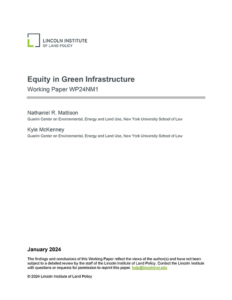Many municipalities introduced their first stand-alone green infrastructure (“GI”) plans in the late 2000s and early 2010s, specifically as a means of achieving compliance with water quality standards set by the federal Clean Water Act. As climate change becomes a more imminent threat and extreme weather events increase in frequency, cities again are turning to GI as a solution. With its ability to sequester greenhouse gases and to prevent or diffuse some of the impacts from extreme weather events—such as flooding and extreme heat—GI has become a key component of modern municipal climate adaptation planning.
At the same time that cities seek to increase their deployment of GI and reap its many benefits, advocates and scholars have raised concerns about whether they are doing so equitably. This paper categorizes advocates’ and scholars’ proposals for advancing equity goals as cities plan and implement GI, arguing that many are concerned with advancing distributive and procedural equity. The paper then analyzes how four cities from across the country—Los Angeles, New York City, Chicago, and Denver—are incorporating equity into their GI-related planning processes. Overall, we find that all of the case study cities show increasing sophistication with respect to at least one—and sometimes more—of the dimensions of equity on which advocates and scholars have been focused. The paper concludes by highlighting several measures that could be helpful for cities to implement as they seek to incorporate equity into their processes for developing GI, as well as by identifying avenues for further research by scholars that we believe would be most helpful for assisting policymakers.

